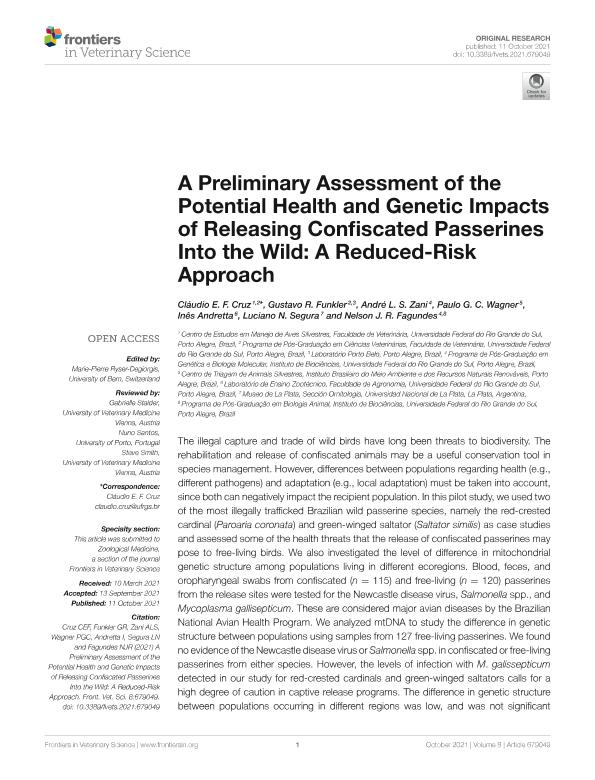Mostrar el registro sencillo del ítem
dc.contributor.author
Cruz, Cláudio E. F.
dc.contributor.author
Funkler, Gustavo R.
dc.contributor.author
Zani, André L. S.
dc.contributor.author
Wagner, Paulo G. C.
dc.contributor.author
Andretta, Ines
dc.contributor.author
Segura, Luciano Noel

dc.contributor.author
Fagundes, Nelson J. R.
dc.date.available
2021-12-03T20:05:35Z
dc.date.issued
2021-10-11
dc.identifier.citation
Cruz, Cláudio E. F.; Funkler, Gustavo R.; Zani, André L. S.; Wagner, Paulo G. C.; Andretta, Ines; et al.; A preliminary assessment of the potential health and genetic impacts of releasing confiscated passerines into the wild: A reduced-risk approach; Frontiers Media; Frontiers in Veterinary Science; 8; 679049; 11-10-2021; 1-11
dc.identifier.issn
2297-1769
dc.identifier.uri
http://hdl.handle.net/11336/148191
dc.description.abstract
The illegal capture and trade of wild birds have long been threats to biodiversity. The rehabilitation and release of confiscated animals may be a useful conservation tool in species management. However, differences between populations regarding health (e.g., different pathogens) and adaptation (e.g., local adaptation) must be taken into account, since both can negatively impact the recipient population. In this pilot study, we used two of the most illegally trafficked Brazilian wild passerine species, namely the red-crested cardinal (Paroaria coronata) and green-winged saltator (Saltator similis) as case studies and assessed some of the health threats that the release of confiscated passerines may pose to free-living birds. We also investigated the level of difference in mitochondrial genetic structure among populations living in different ecoregions. Blood, feces, and oropharyngeal swabs from confiscated (n = 115) and free-living (n = 120) passerines from the release sites were tested for the Newcastle disease virus, Salmonella spp., and Mycoplasma gallisepticum. These are considered major avian diseases by the Brazilian National Avian Health Program. We analyzed mtDNA to study the difference in genetic structure between populations using samples from 127 free-living passerines. We found no evidence of the Newcastle disease virus or Salmonella spp. in confiscated or free-living passerines from either species. However, the levels of infection with M. galissepticum detected in our study for red-crested cardinals and green-winged saltators calls for a high degree of caution in captive release programs. The difference in genetic structure between populations occurring in different regions was low, and was not significant between those from the Pampa/Subtropical Grasslands region. These results suggest that it may be possible to establish a cost-effective and sensitive protocol for releasing confiscated songbirds, provided that further genome-wide studies indicate that the functional genetic diversity among (at least some of the) populations is also low.
dc.format
application/pdf
dc.language.iso
eng
dc.publisher
Frontiers Media

dc.rights
info:eu-repo/semantics/openAccess
dc.rights.uri
https://creativecommons.org/licenses/by-nc-sa/2.5/ar/
dc.subject
ANIMAL WELFARE
dc.subject
MYCOPLASMA
dc.subject
OUTBREEDING DEPRESSION
dc.subject
REHABILITATION AND RELEASE
dc.subject
SEIZED SONGBIRDS
dc.subject
WILD BIRD MANAGEMENT
dc.subject
WILDLIFE POLICY
dc.subject.classification
Zoología, Ornitología, Entomología, Etología

dc.subject.classification
Ciencias Biológicas

dc.subject.classification
CIENCIAS NATURALES Y EXACTAS

dc.title
A preliminary assessment of the potential health and genetic impacts of releasing confiscated passerines into the wild: A reduced-risk approach
dc.type
info:eu-repo/semantics/article
dc.type
info:ar-repo/semantics/artículo
dc.type
info:eu-repo/semantics/publishedVersion
dc.date.updated
2021-11-17T14:50:58Z
dc.journal.volume
8
dc.journal.number
679049
dc.journal.pagination
1-11
dc.journal.pais
Suiza

dc.description.fil
Fil: Cruz, Cláudio E. F.. Universidade Federal do Rio Grande do Sul; Brasil
dc.description.fil
Fil: Funkler, Gustavo R.. Universidade Federal do Rio Grande do Sul; Brasil. Laboratório Porto Belo; Brasil
dc.description.fil
Fil: Zani, André L. S.. Universidade Federal do Rio Grande do Sul; Brasil
dc.description.fil
Fil: Wagner, Paulo G. C.. Centro de Triagem de Animais Silvestres; Brasil
dc.description.fil
Fil: Andretta, Ines. Universidade Federal do Rio Grande do Sul; Brasil
dc.description.fil
Fil: Segura, Luciano Noel. Universidad Nacional de La Plata. Facultad de Ciencias Naturales y Museo. División Zoología de Vertebrados; Argentina. Consejo Nacional de Investigaciones Científicas y Técnicas. Centro Científico Tecnológico Conicet - La Plata; Argentina
dc.description.fil
Fil: Fagundes, Nelson J. R.. Universidade Federal do Rio Grande do Sul; Brasil
dc.journal.title
Frontiers in Veterinary Science
dc.relation.alternativeid
info:eu-repo/semantics/altIdentifier/doi/http://dx.doi.org/10.3389/fvets.2021.679049
dc.relation.alternativeid
info:eu-repo/semantics/altIdentifier/url/https://www.frontiersin.org/articles/10.3389/fvets.2021.679049/full
Archivos asociados
